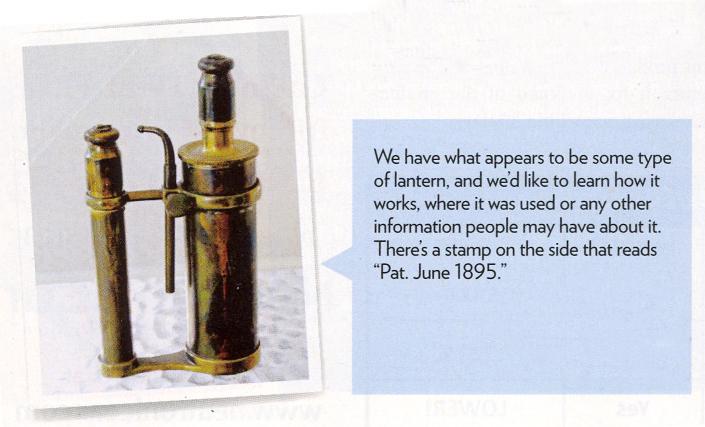| View previous topic :: View next topic |
| Author |
Message |
Elise

Joined: 22 Dec 2009
Posts: 243
Location: New York State



|
 Posted: Jun 28, 2012 12:10 Post subject: Mineral identification using a blowpipe Posted: Jun 28, 2012 12:10 Post subject: Mineral identification using a blowpipe |
|
|
Hi --
I thought members might be interested in this: Dr. William A. Bassett (Professor Emeritus Geology, Cornell) gave me permission to share this on FMF, saying " I sent the following message to someone in reference to an item appearing in the magazine “Country”. I hardly ever do this kind of thing but just couldn’t resist this time."
(letter)
"I think I may be able to help you identify the object (which, by the way, is very handsome) pictured in “Can you help me” in the July 2012 issue of Country. I am both a collector of early lighting and a mineralogist. My experience as the latter proved more helpful.
The pipe with a bend in it caught my eye. It looks just like the blowpipes I had my students use when I started teaching mineralogy 50 years ago. Of course, today, we use X-ray machines, spectrometers, and the like. But the blowpipes were amazingly useful for identifying minerals. We would hollow out a small dish-shaped recess in a block of charcoal, place a grain of the unknown mineral in it, and then by placing the blowpipe at one side of a Bunsen burner flame blow a small jet of very hot flame at it. If it melted, that would limit the options. If it made a silvery bead, that would further limit the choices. If it smelled of sulfur, that provided definite clue. Other smells would indicate arsenic or some other elements of that group. Sometimes the flame would take on a bright color indicating strontium or barium. All in all, it was fun and not only taught the students how to identify minerals but taught a lot of chemistry as well.
I strongly suspect that the item you pictured in the magazine was a very beautifully crafted burner for applying those tests while working in the field. Many such burners used alcohol, but I can’t tell that for sure by looking at the picture. I hope you hear from other mineralogists and prospectors confirming my suspicions. "
Sincerely,
Bill Bassett
| Description: |
| A photo submitted to a magazine along with a question as to the subject's identity (reader's name erased). |
|
| Viewed: |
13491 Time(s) |

|
_________________
Elise Skalwold |
|
| Back to top |
|
 |
gemlover

Joined: 31 Dec 2008
Posts: 211
Location: Easley, SC



|
 Posted: Jul 06, 2012 16:41 Post subject: Re: Mineral identification using a blowpipe Posted: Jul 06, 2012 16:41 Post subject: Re: Mineral identification using a blowpipe |
|
|
What a great memory that brings back. we saw these in the back of the lab, but never used them.
John
_________________
John
John Atwell Rasmussen, Ph.D.. AJP
Geologist and Gemologist |
|
| Back to top |
|
 |
Riccardo Modanesi
Joined: 07 Nov 2011
Posts: 631
Location: Milano


|
 Posted: Jul 07, 2012 14:00 Post subject: Re: Mineral identification using a blowpipe Posted: Jul 07, 2012 14:00 Post subject: Re: Mineral identification using a blowpipe |
|
|
Hi to everybody!
Ok, ity's true it is an ancient and therefore overtaken instrument, but I think people who are really able to use it may achieve many informations about an unknown specimen, even by an analysis at home! The issue is: being able to use it.
Greetings from Italy by Riccardo.
_________________
Hi! I'm a collector of minerals since 1973 and a gemmologist. On Summer I always visit mines and quarries all over Europe looking for minerals! Ok, there is time to tell you much much more! Greetings from Italy by Riccardo. |
|
| Back to top |
|
 |
Ron Layton
Joined: 03 Mar 2009
Posts: 4
Location: Visalia California


|
 Posted: Aug 30, 2012 11:28 Post subject: Re: Mineral identification using a blowpipe Posted: Aug 30, 2012 11:28 Post subject: Re: Mineral identification using a blowpipe |
|
|
| The item pictured is also used for soldering, especially silver. It had a detachable rubber hose and the blowpipe was height adjustable to take advantage of the flame from the alcohol in the lamp section. They are surprisingly efficient and they can be used for blowpipe assay and ID work. I believe I am one of a dieing breed. I still use a blowpipe and Orsino Smith's book as well as many others for mineral ID. I have learned to use a cheap aquarium pump to supply the air. It gives you more freedom to manipulate things. A great book is Donald Peck's "Mineral Identification" available from Mineralogical Record book store. It covers blowpipe and other techniques for mineral ID for those interested.
|
|
| Back to top |
|
 |
Turbo
Joined: 30 Sep 2009
Posts: 260
Location: Delaware



|
 Posted: Aug 30, 2012 17:54 Post subject: Re: Mineral identification using a blowpipe Posted: Aug 30, 2012 17:54 Post subject: Re: Mineral identification using a blowpipe |
|
|
| Interesting! It reminds me of the Hanau torch that is still used today in dental labs. It's basically an alcohol torch with a nozzle that you can angle toward the flame. When the trigger is depressed, a small stream of air blows the flame sideways into a point.
|
|
| Back to top |
|
 |
cascaillou
Joined: 27 Nov 2011
Posts: 263


|
 Posted: Dec 17, 2012 09:42 Post subject: Re: Mineral identification using a blowpipe Posted: Dec 17, 2012 09:42 Post subject: Re: Mineral identification using a blowpipe |
|
|
For such analysis you can use either a regular blowtorch (which you can also get a tight nozzle for), ok to keep things small and cheap you might use a torch lighter:
Dry qualitative analysis include:
fusibility, flame coloration, thermoluminescence, borax pearl and phosphate pearl, heating on charcoal in oxydizing flame and in reducing flame, heating in open tube and in closed tube.
Some equipment might be needed: borax and sodium phosphate for pearls, KHSO4, acids such as HCl, HNO3 and H2SO4, bases like NaOH, KOH and NH4OH, reactives such as Ca(OH)2 and Co(NO3)2, a silver platelet and very thin platinum wire, wood coal pieces.
Then there is wet qualitative analysis, which is much more accurate, but requires a larger collection of chemicals (if you want to be able to test for as much cations and anions as possible, that's a lot of chemicals, which represents quite an investment)
|
|
| Back to top |
|
 |
cascaillou
Joined: 27 Nov 2011
Posts: 263


|
 Posted: Dec 31, 2012 12:28 Post subject: Re: Mineral identification using a blowpipe Posted: Dec 31, 2012 12:28 Post subject: Re: Mineral identification using a blowpipe |
|
|
| By the way there's a book in french language titled "Quel est ce mineral?", by Jean-Claude Berthelay. Unfortunately not published anymore and quite hard to get your hands on, this is as far as I know the one and only book dealing with wet and dry qualitative analysis SPECIFICALLY applied to minerals (with detailed procedures for detection of most cations and anions, of course).
|
|
| Back to top |
|
 |
|




